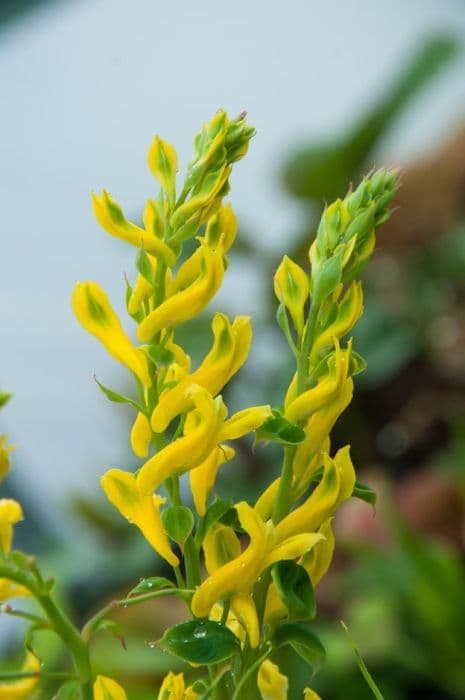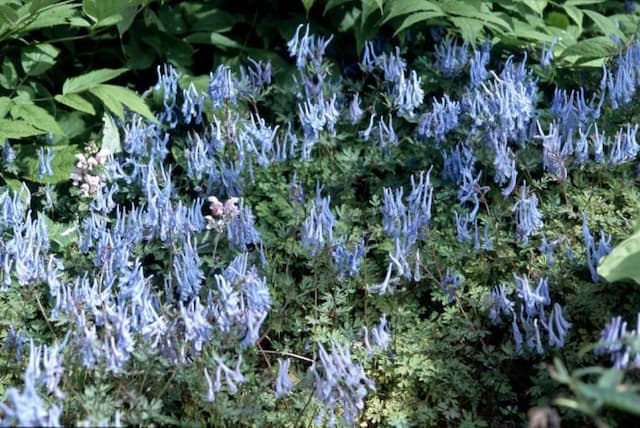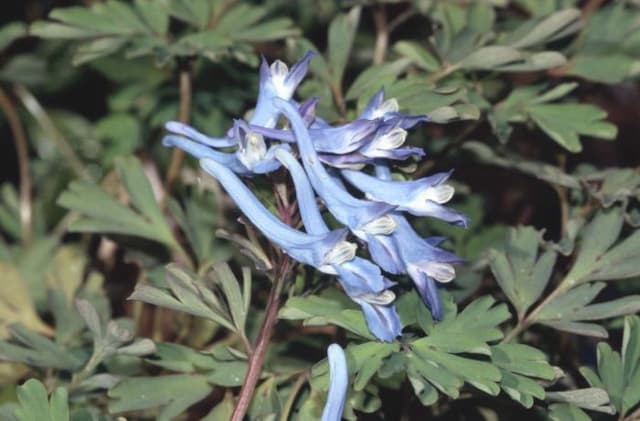Bleeding Heart Dicentra 'Stuart Boothman'

ABOUT
Dicentra 'Stuart Boothman' is a captivating garden plant commonly known as bleeding heart, named for its unique heart-shaped flowers. These blooms are an alluring shade of deep pink with an inner petal that is white, creating a striking two-toned effect. The flowers gracefully dangle in a row from arching stems, resembling a line of delicate lockets. The foliage of this particular cultivar is also noteworthy, featuring a frothy texture with fern-like leaves that are a soft green color. The leaves may have a slightly blue or gray cast, adding to the ornamental value of this bleeding heart variety. Overall, the bleeding heart exudes a romantic and whimsical presence in any garden setting, enchanting onlookers with its storybook appearance.
About this plant
 Names
NamesFamily
Papaveraceae.
Synonyms
Bleeding Heart, Dutchman's Breeches.
Common names
Dicentra 'Stuart Boothman'.
 Toxicity
ToxicityTo humans
Bleeding heart is the most common common name for Dicentra 'Stuart Boothman'. This plant has components that are considered toxic to humans if ingested. Members of the Dicentra genus contain isoquinoline alkaloids which can cause symptoms such as vomiting, diarrhea, dizziness, and skin irritation upon contact. While serious poisoning is rare, consumption of parts of this plant could potentially lead to convulsions and other neurological effects. Medical attention should be sought immediately if ingestion is suspected.
To pets
Bleeding heart is also toxic to pets, such as dogs and cats. Like in humans, the isoquinoline alkaloids present in the plant can cause vomiting, diarrhea, and in severe cases, seizures or tremors if ingested. It is important to prevent pets from chewing on or eating any part of the plant, and to consult a veterinarian promptly if the plant has been consumed by a pet.
 Characteristics
CharacteristicsLife cycle
Perennials
Foliage type
Deciduous
Color of leaves
Green
Flower color
Pink
Height
1-2 feet (30-60 cm)
Spread
1-2 feet (30-60 cm)
Plant type
Herb
Hardiness zones
5
Native area
Asia
Benefits
 General Benefits
General Benefits- Aesthetic Appeal: Adds delicate beauty to gardens with its arching stems and heart-shaped flowers.
- Attracts Pollinators: Brings bees and butterflies to the garden, aiding in the pollination of plants.
- Low Maintenance: Requires minimal care once established, making it ideal for busy gardeners.
- Tolerance to Shade: Thrives in shaded areas where other plants may struggle to grow.
- Seasonal Interest: Offers a unique bloom shape that adds interest during its flowering season.
- Deer Resistance: Less appealing to deer, which helps to prevent damage to the plant and garden.
- Drought Tolerance: Capable of surviving periods of low water, though prefers consistently moist soil.
- Non-Invasive: Unlike some other plants, it does not tend to spread uncontrollably, making it garden-friendly.
- Hardiness: Can withstand colder temperatures, suitable for growing in many climates.
- Long Blooming: Provides flowers for a long period, often from late spring to early summer.
- Emotional Wellbeing: Enhances the overall aesthetic of a space which can contribute to stress reduction and relaxation.
- Easy to Propagate: Can be easily divided to create new plants for other areas of the garden or to share.
- Compact Growth: Ideal for small gardens, borders, or as a part of a mixed container due to its non-spreading habit.
 Medical Properties
Medical PropertiesThis plant is not used for medical purposes.
 Air-purifying Qualities
Air-purifying QualitiesThis plant is not specifically known for air purifying qualities.
 Other Uses
Other Uses- As a natural dye: Dicentra 'Stuart Boothman' may be used to create natural dyes for fabrics due to its pigments, particularly from the flowers or stems.
- In garden photography: The unique heart-shaped flowers and blue-green foliage make it a popular subject for garden photographers and nature artists.
- As a muse for jewelry design: Jewelry designers sometimes mimic the distinct shapes of Bleeding Heart flowers in their pieces.
- Educational tool: Dicentra 'Stuart Boothman' can be used in educational settings to teach about pollination and plant biology due to its interesting flower structure.
- Beekeeping attraction: Planting Dicentra 'Stuart Boothman' can attract bees to a garden, which can be beneficial for beekeepers in the vicinity.
- As a cut flower: Although not as long-lasting as other species, the flowers can be used in cut flower arrangements for their unusual appearance.
- Companion planting: Some gardeners use Dicentra 'Stuart Boothman' alongside other shade-loving perennials to create aesthetically pleasing and environmentally supportive garden designs.
- Culinary decoration: While not commonly used and to be used with caution as parts of the plant can be toxic, the flowers can occasionally serve as an unusual garnish (ensuring no consumption).
- Flower pressing: The distinctive flowers of Dicentra 'Stuart Boothman' can be pressed and used in crafts or as botanical specimens for hobbyists.
- Creating secluded garden spots: Because it thrives in shade, it's ideal for planting in secluded spots of the garden where few other flowering plants would grow.
Interesting Facts
 Feng Shui
Feng ShuiThe Bleeding heart is not used in Feng Shui practice.
 Zodiac Sign Compitability
Zodiac Sign CompitabilityThe Bleeding heart is not used in astrology practice.
 Plant Symbolism
Plant Symbolism- Love and Devotion: The Dicentra, also known as Bleeding Heart, is often associated with feelings of love and deep emotion, given its heart-shaped flowers that seem to "bleed."
- Sorrow and Rejection: In line with its name, the Bleeding Heart can symbolize a profound sorrow or the pain of rejection, as the droplets at the bottom of the heart-shaped flowers can represent tears.
- Grace and Elegance: With its arching stems and delicate flowers, the Bleeding Heart is frequently seen as a symbol of grace and elegance in the plant world.
- Compassion and Empathy: Because of its heartfelt shape and appearance, some interpret the Bleeding Heart as a sign of compassion and empathy, symbolizing an open-hearted individual.
 Water
WaterBleeding hearts, such as the Dicentra 'Stuart Boothman', should be watered deeply once a week, ensuring that the soil is moist but not waterlogged. During the growing season, you might need to increase the frequency to two times per week, especially in hotter, drier climates. Each time you water, aim to provide about one gallon per plant, depending on the size and maturity. It's essential to reduce watering in the fall as the plant goes dormant, and during winter months, only water enough to prevent the soil from completely drying out.
 Light
LightBleeding hearts prefer to be in a spot that provides partial shade or dappled sunlight, as too much intense sun can damage the foliage. They thrive under the canopy of taller trees or on the north side of a building where they can be sheltered from the harsh afternoon sun. Morning light with afternoon shade is ideal for this delicate perennial.
 Temperature
TemperatureBleeding hearts like cool to moderate temperatures and can generally withstand temperatures as low as 20 degrees Fahrenheit but may die back at freezing temperatures; they perform best in temperatures between 55 and 75 degrees Fahrenheit. It's crucial to protect the plant from extreme heat and frigid winter conditions to prevent damage or loss of the plant.
 Pruning
PruningBleeding hearts should be pruned to remove spent flowers and yellowing leaves, which encourages new growth and improves the plant's appearance. The best time to prune is after flowering, typically in late spring or early summer. Cut back the foliage to the base in late fall or early winter when the plant starts to die back naturally. Regular pruning is not usually necessary, but periodic tidying can help maintain a healthy and attractive plant.
 Cleaning
CleaningAs needed
 Soil
SoilThe Bleeding Heart 'Stuart Boothman' thrives best in organically rich, moist, well-drained soil with a pH range of 6.0 to 7.5. A soil mix of peat moss, compost, loam, and perlite can ensure good drainage and fertility to promote healthy growth.
 Repotting
RepottingBleeding Heart 'Stuart Boothman' typically does not need to be frequently repotted and can be done every 3-4 years or when it outgrows its container.
 Humidity & Misting
Humidity & MistingBleeding Heart 'Stuart Boothman' prefers moderate to high humidity levels, ideally between 50% to 70%.
 Suitable locations
Suitable locationsIndoor
Keep in bright, indirect light, maintain moist soil.
Outdoor
Shelter from strong wind, partial shade, moist soil.
Hardiness zone
3-9 USDA
 Life cycle
Life cycleThe plant Dicentra 'Stuart Boothman', commonly known as Fern-leaf Bleeding Heart, begins its life cycle with seed germination, where it requires a period of cold stratification to break dormancy. Once germinated, the seedling grows into a small plant with characteristic fern-like foliage, proceeding through a vegetative growth stage where it develops its root system and foliage mass. The next stage is flowering, usually occurring in late spring to early summer, where it produces distinctive heart-shaped pink and white flowers that attract pollinators. After pollination, if successful, the plant sets seed, developing small seed pods that eventually dry and release seeds for the next generation. In fall, as temperatures drop, Fern-leaf Bleeding Heart enters a period of dormancy where the above-ground foliage dies back, while the roots survive underground in a dormant state. In the following spring, the plant emerges from dormancy, resuming its growth cycle by sending up new shoots from its rootstock.
 Propogation
PropogationPropogation time
Spring-Early Summer
Propogation: The Dicentra 'Stuart Boothman', commonly known as Fernleaf bleeding heart, is most effectively propagated through division. This method is best carried out in the early spring or after the plant has finished flowering in the late summer to early fall. Begin by carefully digging up the plant, ensuring that you don't damage the roots. Gently separate the clump into smaller sections, each with at least one growth bud. Replant these divisions at the same depth they were originally growing, spacing them about 12 to 18 inches (30 to 45 centimeters) apart to allow ample room for growth. Water the newly planted sections thoroughly to help establish them. With proper care, these divisions will grow into healthy, flowering plants in the following season.









